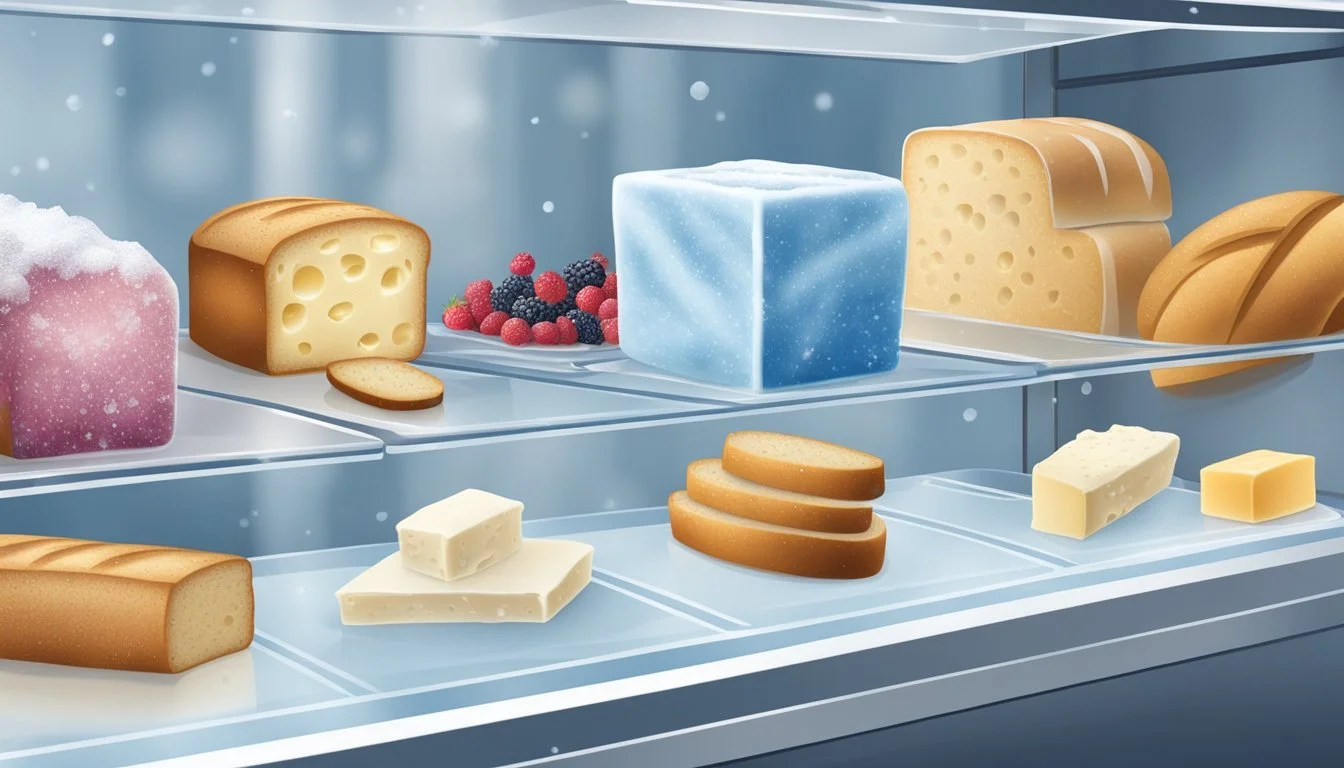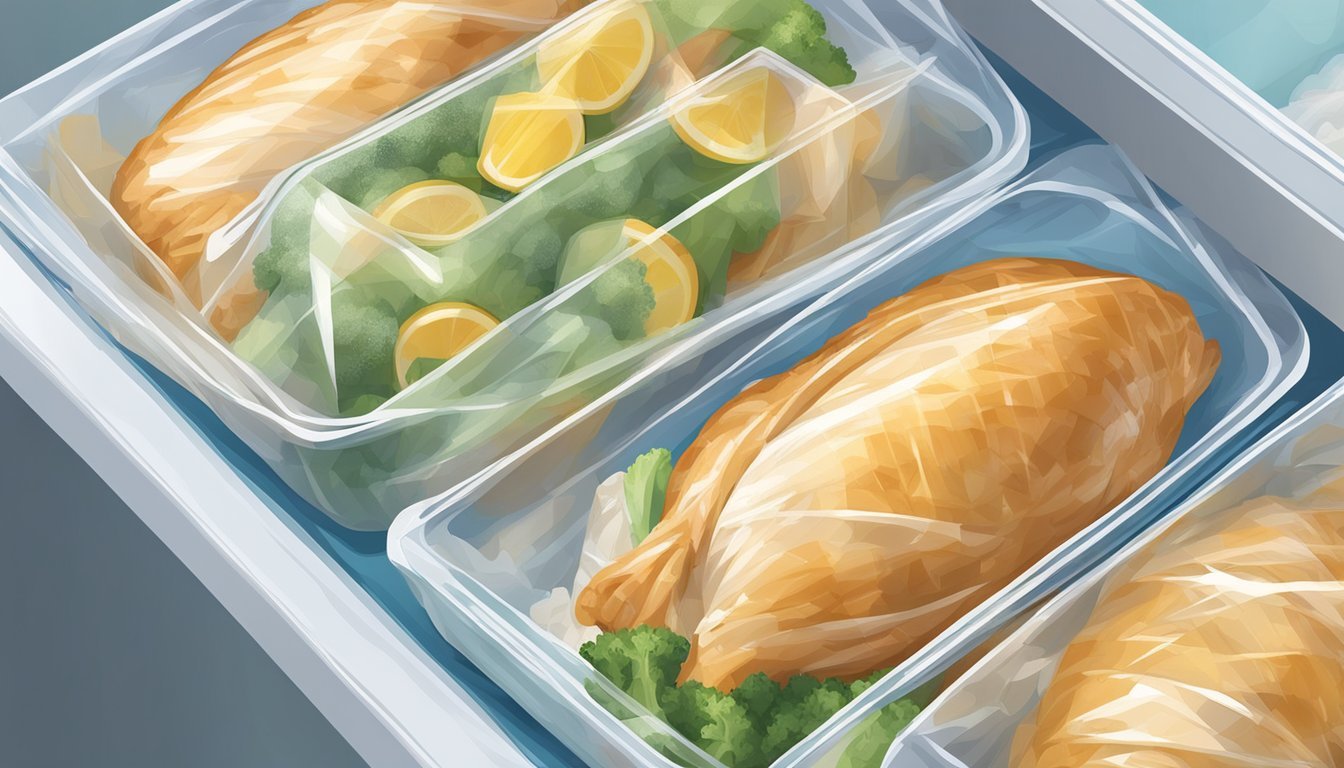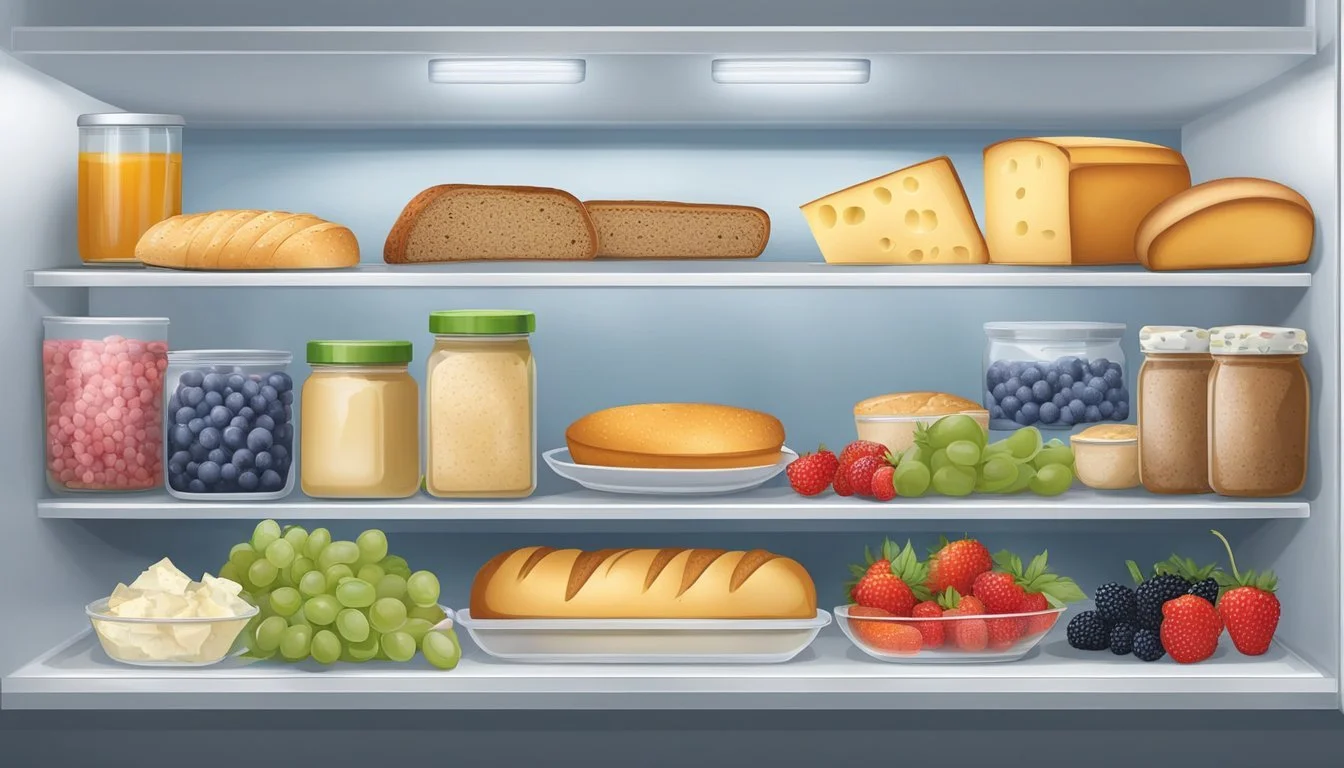10 Foods That You Can Freeze to Extend Their Shelf Life
Essential Tips for Freshness
Freezing food is a proven method to extend its shelf life, ensuring that you always have nutritious options available, even when fresh supplies run out. This technique not only helps in reducing waste but also saves money by allowing you to buy in bulk and preserve those ingredients for later use.
Understanding which foods freeze well can help you maximize your freezer's potential and keep your meals varied and flavorful. From vegetables and meats to certain dairy products and pre-cooked dishes, many common items can be successfully frozen without losing their quality.
1) Sliced Bread
Sliced bread is a staple in many households, and freezing it can significantly extend its shelf life. To freeze sliced bread, start by arranging the slices in a plastic bag. Removing as much air as possible before sealing helps maintain freshness.
Another effective method is wrapping the slices in plastic wrap before placing them in a resealable bag. This double-layer protection prevents freezer burn, preserving the bread's quality.
For best results, freeze bread as soon as possible after purchase. This minimizes the risk of mold and ensures the bread remains soft and flavorful when thawed. If the bread is homemade, allow it to cool completely before freezing.
When ready to use, slices can be defrosted at room temperature or toasted directly from the freezer. This makes it convenient for those quick morning meals or packed lunches. These freezing tips provide a simple yet effective way to enjoy fresh bread anytime.
2) Chicken Breasts
Chicken breasts are a versatile and nutritious protein that can be easily preserved by freezing. To maintain their quality and flavor, proper preparation and storage techniques are essential.
Start by selecting fresh chicken breasts. Washing and patting dry the chicken is a crucial next step. For best results, wrap each chicken breast individually in plastic wrap or freezer paper.
Once wrapped, place the individually wrapped breasts in a freezer-safe bag. Be sure to push out as much air as possible before sealing the bag. This prevents freezer burn and helps maintain the chicken's quality.
Using freezer-safe packaging is important to keep the meat free from moisture and air. Labeling and dating each package aids in keeping track of how long the chicken has been stored.
The USDA suggests an additional layer of protection if you plan on freezing the chicken in its original packaging. Wrapping the container in aluminum foil, plastic wrap, or freezer paper adds a barrier against air exposure.
For thawing, it's recommended to transfer the chicken to the refrigerator 24 hours before cooking. This gradual thawing method is safe and helps retain the chicken’s texture and taste.
3) Berries
Freezing berries is an excellent way to extend their shelf life. By following a few simple steps, you can preserve their freshness and flavor for months.
To start, wash the berries in a diluted vinegar bath (1 cup vinegar to 3 cups water). This helps eliminate mold and bacteria. Afterward, rinse them under cool running water.
Dry the berries thoroughly before freezing. Moisture on the berries can cause ice crystals, which can affect texture and taste. Spread the berries in a single layer on a baking sheet lined with parchment paper. Ensure they are not touching each other.
Place the baking sheet in the freezer for a few hours until the berries are firm. Once frozen, transfer the berries to airtight bags or containers. Press out as much air as possible to prevent freezer burn.
Storing berries in airtight packaging maintains their quality. Label the bags or containers with the date, so you know when they were frozen. This can help you stay organized and use older berries first. Following these steps ensures that you can enjoy fresh-tasting berries even months after freezing them.
4) Avocado Slices
Freezing avocado slices is a practical way to extend their shelf life. By doing so, one can preserve their avocados without worrying about them spoiling too quickly.
To freeze avocado slices, start by choosing ripe yet firm avocados. Overly ripe avocados may not freeze well and can become mushy.
Slice the avocados in half lengthwise and remove the pit. Carefully scoop out the flesh using a spoon, keeping the pieces as intact as possible.
For optimal preservation, consider adding a small amount of lemon or lime juice to the avocado slices to prevent browning. About one teaspoon of juice per avocado half works well.
Place the avocado slices on a tray or baking sheet lined with wax or parchment paper. Freeze the slices for 2-4 hours until they are solid.
Once frozen, transfer the slices to a resealable freezer bag, ensuring most of the air is removed to prevent freezer burn. Properly stored, avocado slices can last in the freezer for up to three months.
Frozen avocado slices can be used in various dishes like smoothies, guacamole, and salads without significant loss of flavor or nutritional value.
5) Cheese Blocks
Cheese blocks can be effectively frozen to extend their shelf life. Hard cheeses like cheddar, Swiss, and blue cheese are particularly well-suited for freezing.
To freeze cheese blocks, it is crucial to wrap them tightly in plastic wrap or aluminum foil to prevent any exposure to air, which can cause freezer burn.
After wrapping, place the cheese blocks in a freezer-safe bag or airtight container. Label the packaging with the type of cheese and the date it was frozen.
Frozen cheese blocks can maintain their quality for 6 to 9 months. When thawed, the texture might change slightly, becoming a bit crumbly. This does not affect the flavor or safety of the cheese.
Remember to thaw the cheese slowly in the refrigerator for the best texture results. Using frozen cheese in cooked dishes is ideal, as minor texture changes are less noticeable.
6) Butter
Butter, a staple in many kitchens, can be frozen to extend its shelf life significantly. Ideal for both salted and unsalted varieties, freezing butter helps maintain its freshness and quality for up to a year.
For the best results, wrap the butter in its original packaging or aluminum foil. This prevents freezer burn and keeps unwanted odors from affecting the flavor.
Before freezing browned butter, let it cool completely. Transfer it to an airtight container, leaving some space at the top to allow for expansion.
To avoid clumping and make portioning easier, you can freeze butter in smaller portions. Use ice cube trays or portion out sticks before freezing. This method allows for quicker thawing and easier use in recipes.
Store the butter at or below 0°F (-18°C) in the freezer. This consistent temperature helps maintain the texture and taste of the butter over time.
Following these storage practices ensures that your butter remains a versatile and rich ingredient in your kitchen.
7) Herbs
Freezing fresh herbs can be an excellent way to extend their shelf life while retaining much of their flavor. For leafy herbs like basil, mint, or parsley, remove the stems and chop the leaves into manageable sizes.
One popular method involves spreading the chopped herbs in a single layer on a parchment-lined baking sheet. Place the sheet in the freezer for a few hours until the herbs are frozen solid. Once frozen, transfer them to a zipper-lock bag for long-term storage.
Another effective technique is to use a food processor to chop whole leaves with a small amount of oil. This herb-oil mixture can be distributed into ice cube trays and frozen until solid. Once the cubes are frozen, store them in a zipper-lock bag for easy access.
Herbs stored in this way can be conveniently added to soups, stews, and sauces without the need for thawing first. This method helps preserve the fresh taste and aroma of the herbs, making them a valuable addition to any kitchen.
By using these simple freezing methods, herbs can be preserved effectively, reducing waste and ensuring they remain a flavorful ingredient all year round.
8) Tomato Paste
Tomato paste is a staple in many kitchens due to its rich, concentrated flavor. Freezing tomato paste is a practical way to extend its shelf life and avoid waste.
Once opened, tomato paste typically lasts 5 to 7 days in the fridge when stored in an airtight container. By freezing, it can remain usable for up to 3 months.
To freeze tomato paste, spoon it onto a parchment-lined baking sheet in 2-tablespoon portions. Once solid, transfer the portions to a resealable freezer bag or airtight container. This method ensures easy-to-use portions for future recipes.
When ready to use, thaw the required amount in the refrigerator or at room temperature. This way, the integrity and flavor of the paste remain intact.
Freezing extends the usefulness of tomato paste in various dishes, allowing you to capture the taste of peak-season tomatoes year-round. For added convenience, ensure the portions are well-labeled with the date of freezing.
9) Soup
Soup is an excellent candidate for freezing, providing convenience and reducing waste. Many types, such as chicken tortilla, vegetable, and lentil, retain their flavors and textures well.
For best results, avoid freezing soups with dairy or potatoes, as these ingredients can become grainy or separate when thawed.
Storing soup properly is crucial. Allow it to cool completely before transferring it to airtight containers or freezer-safe bags. Label each container with the date and type of soup to keep track of storage time.
Defrosting is straightforward. Thaw soup in the refrigerator overnight or use a water bath for quicker results. Reheat on the stove, adding stock or water if needed to adjust the consistency.
Avoid freezing soup with toppings like noodles or fresh herbs. These should be added fresh when serving. Freezing soups this way ensures they remain delicious and satisfying after reheating.
10) Bananas
Bananas are a popular fruit that can be frozen to extend their shelf life. To freeze bananas, first peel them. Cut the bananas into slices, about 1/2 inch thick, and lay them out on a parchment-lined baking sheet. This prevents them from sticking together.
Place the baking sheet in the freezer. Once the banana slices are solid, transfer them to an airtight container or a plastic bag.
Freezing bananas this way makes them convenient for smoothies or baking. The texture changes when thawed, becoming mushy, but the flavor remains great.
For those who prefer, whole peeled bananas can be frozen. Wrap each one in plastic wrap, then put them in a container or a bag. This method works best for recipes that call for mashed bananas.
Benefits Of Freezing Food
Freezing food can help preserve important nutrients, save money, and reduce food waste. This process offers several advantages that can be beneficial for both your health and your wallet.
Nutritional Preservation
Freezing food helps maintain most of its nutrients. Enzymes that cause food to spoil are inactivated at low temperatures. This means that frozen fruits and vegetables can retain their vitamins and minerals for extended periods.
Freezing also halts the growth of bacteria and molds that cause food to decay. This preserves the food’s original quality. To maximize nutrient retention, it’s essential to freeze food at its peak ripeness.
Tip: For best results, blanch vegetables before freezing to improve color, texture, and nutritional value.
Cost Efficiency
Freezing allows consumers to take advantage of sales and bulk buying opportunities. When food is bought in larger quantities and preserved correctly in the freezer, it reduces the need for frequent grocery trips and lowers grocery bills.
By freezing foods that are nearing their expiration dates, you can extend their usability. This means less food gets wasted, and you ultimately save money. Leftovers can also be frozen, allowing you to make the most of every meal.
Example: Purchasing meat in larger packages and freezing individual portions can be more cost-effective.
Reduction Of Food Waste
Freezing food can significantly reduce household food waste. Foods that might otherwise spoil can be frozen and used at a later date. This is especially useful for perishable items like fruits, vegetables, and meats.
Reducing food waste is not only beneficial for your budget but also for the environment. Less food waste means less methane emissions from decomposing food in landfills. Freezing offers a practical solution to manage excess food and ensure it doesn’t go to waste.
Note: Make sure to label and date frozen foods for better inventory management and usage.
Best Practices For Freezing Food
Freezing food can effectively extend its shelf life if done correctly. Key practices include proper packaging techniques, thorough labeling and dating, and maintaining the ideal storage temperature.
Proper Packaging Techniques
Properly packaging food is crucial to prevent freezer burn and maintain quality.
Wrap and seal food tightly: Use materials like foil, plastic wrap, and plastic freezer bags. Ensure that the wrapping is airtight to avoid moisture loss.
Dividing portions: Separate food into meal-sized portions before freezing. This reduces waste and makes thawing more convenient.
Containers: Use freezer-safe containers for liquids and casseroles to maintain quality and prevent spills.
Labeling And Dating
Clear labeling ensures that food is consumed within a safe timeframe.
Label everything: Mark packages with the food name and date of freezing. This helps in identifying contents and rotating stock.
Use clear and readable labels: Use permanent markers or freezer labels. Ensure the writing is legible to avoid confusion.
Date formats: Consistently use the same date format, such as MM/DD/YYYY, for ease of tracking.
Ideal Storage Temperature
Maintaining the correct freezer temperature ensures food safety and quality.
Temperature setting: Keep the freezer at 0°F (-18°C) or lower. This ensures that food remains frozen and prevents bacterial growth.
Check regularly: Use a reliable thermometer to monitor the freezer’s temperature. Make adjustments if necessary to maintain optimal conditions.
Avoid overloading: Do not overcrowd the freezer, as proper air circulation is vital for even cooling. Adjust the layout to allow efficient air flow.
By following these best practices, the shelf life and quality of frozen foods can be maximized, ensuring they remain safe and delicious for longer periods.







